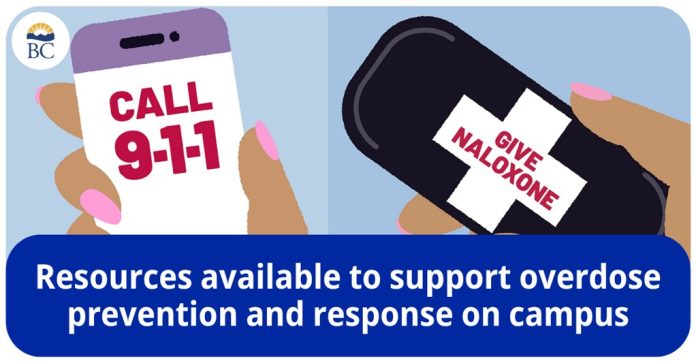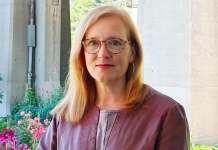As post-secondary students prepare to head back to class for the fall semester, students and staff are reminded of the resources available to prevent and respond to overdoses on campus.
“Every life lost to the toxic-drug crisis is a profound tragedy for our communities, and I expect all public post-secondary institutions to take steps to protect students,” said Jessie Sunner, Minister of Post-Secondary Education and Future Skills. “That’s why my ministry directed the creation of overdose prevention and response guidelines to enhance and align the strategies of our public post-secondary institutions. The Overdose Prevention and Response Steering Committee is continuing its work to update these guidelines and build on the progress made to improve campus safety.”
To support post-secondary communities in protecting students, the Province has distributed 1,600 nasal naloxone kits to all public post-secondary institutions and First Nations mandated institutes. Free nasal naloxone is available anonymously in designated cabinets across campuses, student health clinics and residence buildings. These locations are usually near emergency phones or automated external defibrillators, making life-saving medication quick and easy to access in case of an overdose.
This is part of the work of the post-secondary overdose steering committee, which was established to review existing policies, identify gaps and establish leading practices for overdose prevention and response across all public post-secondary institutions.
Over the past year, the steering committee has made progress to keep students, staff and faculty safe from harm. This includes releasing guidelines to help institutions develop their own overdose prevention and response plans. These plans help raise awareness and establish clear protocols for responding to drug-poisoning emergencies. Institutions are also advised to provide their faculty and security staff with certified training about how to recognize and respond to an overdose.
Post-secondary institutions throughout B.C. have programs and policies in place to support people’s safety and raise awareness of the dangers of substance use and overdose prevention, such as educational outreach, workshops, harm-reduction resources integrated into student orientation, and access to counselling services. The guidelines released in August 2024 help post-secondary institutions adapt their policies to best practices for the sector.
Students have access to mental-health and addiction services that fit their needs, including the Foundry network, which offers in-person and online health and wellness services for youth and their families, and Here2Talk, a free, 24/7 mental-health counselling service for post-secondary students.
The Province remains committed to combating the toxic-drug crisis on all fronts and is working collaboratively with post-secondary institutions through the steering committee to strengthen efforts to keep students safe on campus. The steering committee continues its work throughout the year, with a focus on updating its guidelines and improving training and communications related to overdose prevention and response.
Quotes:
Lane Trotter, president, Camosun College –
“The safety and well-being of students is always our highest priority. We are proud to work alongside the Province and sector partners to address the toxic-drug crisis through education, harm reduction, and timely access to life-saving resources. Camosun College is committed to raising awareness, reducing stigma and empowering our community to respond effectively in an emergency.”
Cindy Heitman, president and CEO, College of New Caledonia (CNC) –
“At CNC, safety is a shared responsibility and prevention is one of our strongest tools. By ensuring naloxone kits are readily available across all campuses, training our security teams and making it easy to call for help in an emergency, we’re taking practical steps to protect our community. In moments of crisis, having the right resources close at hand can save lives, and that’s a responsibility we take to heart.”
Neil Fassina, president, Okanagan College (OC) –
“As we head back into the school year, we continue to prioritize the safety of everyone at Okanagan College and in our community. Naloxone kits are located across our campuses and in student housing, along with other first-aid equipment, because these resources can be the critical difference in an emergency. We are committed to providing information, training and safe spaces for supportive conversations, so that students, employees and visitors to OC are protected, and we do what we can to prevent deaths due to overdose.”
Dilson Rassier, provost and vice-president, academic, Simon Fraser University –
“At Simon Fraser University, we are proud to work alongside the Province and our post-secondary partners to strengthen overdose prevention and response across our three campuses. The toxic-drug crisis knows no boundaries and expanding access to nasal naloxone, along with implementing sector-wide guidelines, are vital steps to protect our community. We remain committed to raising awareness of these life-saving resources as part of our broader initiatives, fostering a campus culture rooted in safety, compassion and informed support.”
Airini, president and vice-chancellor, Thompson Rivers University (TRU) –
“The toxic-drug crisis claims lives across B.C. every day, and university campuses are not immune. As a society, we have lost too many bright young people to this public-health emergency. At TRU, we are acting to change that by ensuring naloxone is within reach, by training our community to respond and by talking openly about substance use and overdose. These are actions we hope will save lives. People need help to survive, recover and continue their journey. We all have a role to play.”




